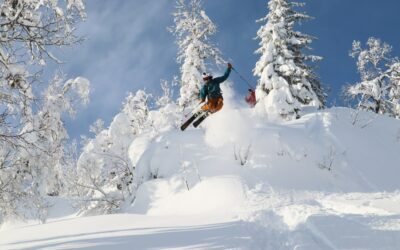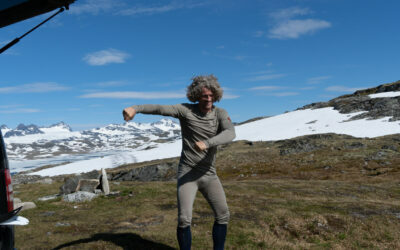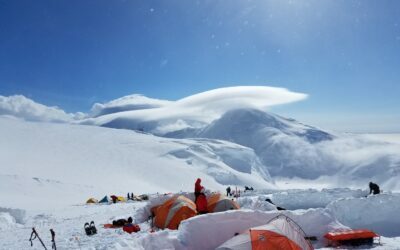The three-layer principle
Three thin layers are better than one. It’s warmer than one single layer. And you can adapt it to changing conditions. If you need a cunning mnemonic for inside to outside, try wooly, warming, weatherproof. Let’s get into the details.

Inner layer: wool
If you are Norwegian and you are currently outside your house and it is not high summer, you will have wool against your skin. This is the way. Wool against the skin is the first layer in the three-layer principle of dressing for all weathers.
Why, you ask? Wool insulates even when it’s wet. You want to sweat into wool. It wicks moisture away from the skin. Wool acts as a temperature regulator. It’s protective in both cold and warm weather. Compare it to cotton, which retains water and dries slowly when it gets wet. And then wear wool.
The lanolin found in wool is naturally anti-bacterial and resistant to funk – wooly socks are infinitely more pleasant to be around when you take your boots off in the hut. Lanolin also helps to make wool naturally water resistant; light rain, snow and stains won’t penetrate far.
Woollen clothes also tend to hold up better over time. They’re easier to keep clean and wrinkle-free. They don’t need to be cleaned with the same frequency and don’t shed non-biodegradable microfibres.
Merino wool, with its tighter weave, is superior to other types of wool in warmth and weight. Wool’s even naturally flame retardant. If you get embers or flames on the wool, it’ll barely smoulder. This is very handy when you’re starting a fire, for obvious reasons.We’ve been farming sheep for their wool for some 6,000 years or so. Sheep are commonly held to be stupid. But there are about a billion of them, and they’ve all chosen to wear wool, so…
Middle layer: – Ull, fleece eller primaloft
The middle layer must insulate: keep heat in, cold out. The choice here also depends on the activity. There are several types of middle layers, but for practical reasons it’s good if this is light and doesn’t take up too much space. While you’re active, this layer’s often in your pack.
For more strenuous activity, however, we recommend a fleece or an extra woollen shirt.
Most of us prefer some kind of insulated jacket or sweater as an intermediate layer. It can either be a synthetic insulation jacket, a thin down jacket, an more-insulated wool jacket or a medium-thick fleece. Jackets like these work something like walls insulation. They capture more air, which in turn heats up and retains the heat between the fibres. Insulated jackets are the warmest middle layer and provide the best ratio between warmth and weight.
In any case, an extra mid-layer garment is always good to have with you out on a tour.
Let’s talk layers.
Outermost layer – shell or insulation
The outermost layer must protect against weather and wind. It’s also important that it can release moisture transported through the first and second layers. A shell or light soft-shell jacket or a padded jacket, depending on weather conditions, is recommended. A highly water-resistant shell jacket with options for ventilation under the arms is never a bad choice.
Soft-shells work nicely in high-activity exercise and as wind protection because it breathes well and, usually, comfortable, being stretchy
A waterproof shell jacket and trousers, preferably made of GoreTex or another membrane, is as a hiking staple in case of rain.

Five tips for hitting the slopes with skins!
Five rules for skinning up a mountain safely and enjoyably. A truly competent, experienced ski guide would probably say there should be about twenty. We’re sticking to five get this true wisdom to stick! Consider these rules the basic pillars of laying down ski tracks right – a checklist of things to remember the next time you point your skis to the peak.

Eight things to check before you start the season
Before you drop everything at the first sign of snow and rush out to ski, keep yourself and your crew safe by checking that you’re “avalanche ready” before the season really starts!

Photography on tour
Capturing moments of magic with a camera can add an extra dimension to the tour experience. With a little system and some simple steps, you can become an even better photographer. Here are some tips how.

Field repair kit
Bringing a repair kit can be very useful, even if you’re not going on a long expedition. Preparation, as always, is never a bad thing.

Wool is completely excellent
Norway’s famous for its changeable weather. Even in summer it can vary from 5° to 30° C. Such variable weather makes it difficult to know how to dress – which is why we say “ull er gull”: wool is gold. Wool keeps you warm in winter, and regulates your temperature in the summer. Wool is the best. A billion sheep can’t be wrong.

Preparing for Åsnes Expedition Amundsen
Dreaming of an adventure in the winter mountains? Or a lover of endurance races? Maybe Åsnes Expedition Amundsen is for you. But you’ll need to be ready.